It’s a busy time in the mountain bike world with new bikes launching seemingly every few days. Sea Otter is coming up in about a week, and brands are rushing to expose their latest and greatest products to the world before the typical onslaught of new components, apparel, and accessories that we’re sure to be seeing.
Just three weeks ago, Yeti launched the lightest full-suspension bike they’ve ever made, their new cross-country race bike, the ASR. Today, Yeti unveils the latest version of the SB165, a bike designed for riding on essentially the complete opposite side of the mountain bike spectrum. Rather than a complete redesign, Yeti made a number of updates in an effort to refine the SB165 and keep it positioned squarely as the long travel park, play, and freeride bike in their lineup.
Yeti sent me a size Large T3 XO Transmission build of the new SB165 ($9,200) a few weeks ago, and I’ve had the chance to get out on it for a few rides so far. I’ll share my ride impressions, but first, let’s dive into the updates and details of the new SB165.

2024 Yeti SB165
The most notable update to the SB165 is the move to mixed wheel sizes. The previous version featured 27.5-inch wheels front and rear and this change brings it in line with the ever-growing crop of mixed-wheel bikes on the market. While this may come to the dismay of the 27.5-ain’t-dead crowd, the Yeti team told me the goal was to enhance the plowability of the front end while maintaining the quickness and maneuverability of the rear.
For travel, the SB165 still has, as the name suggests, 165mm of travel controlled by their unique Switch Infinity suspension design. All complete builds come with Fox Factory DHX2 Coil shocks paired with 170mm travel Fox 38 forks. Keen-eyed observers may notice that is 10mm less fork travel than the previous version, a move I assume is intended to better balance the geometry with the larger front wheel.
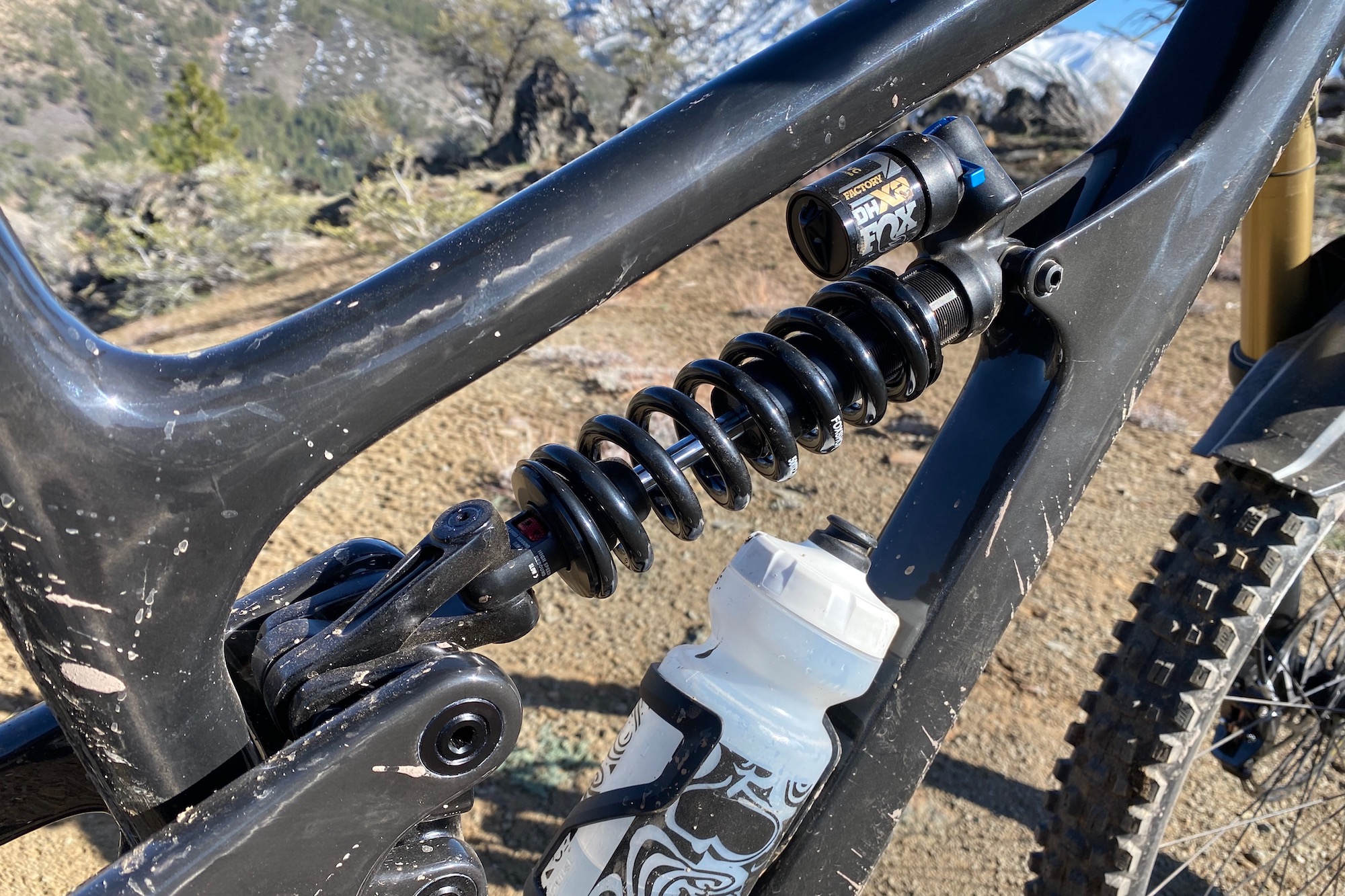
On that note, a number of geometry tweaks have also been made. These include size-specific rear center lengths with the goal of providing better fore-aft balance. Chainstay measurements increase by 2mm per size between the Small and XL frames from 433mm to 439mm, respectively. While that may seem fairly insignificant, remember that this is still intended to be a playful bike for slashing, hitting jumps, riding steeps, and sending big hits at Rampage, and the relatively short chainstays help keep the rear end feeling sporty.
Yeti also straightened the seat tubes to maximize dropper post insertion and the bottom bracket has been lowered slightly to enhance stability. At the front of the bike, stack numbers have increased slightly and they spec’d 30mm rise bars to optimize the rider’s position for the steep, aggressive terrain they expect riders to be tackling on the SB165.
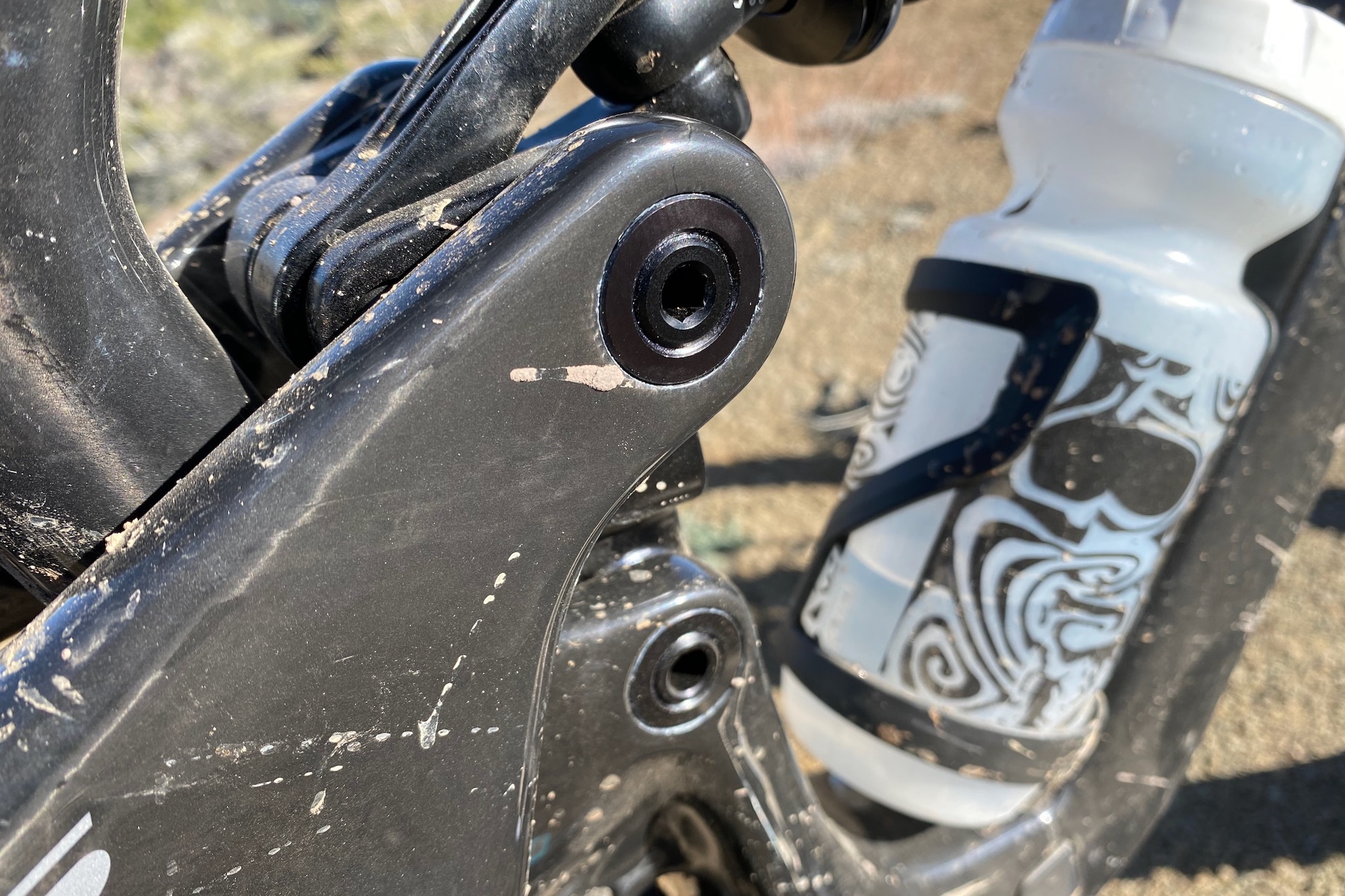
On the frame itself, several changes were made for easier serviceability. All bearings are now pressed into aluminum, not carbon fiber, and standard-size Enduro Max bearings are used to make them sourcing them easier. The precision-machined floating collet axles should help maintain better alignment and smooth suspension movement. A threaded bottom bracket shell makes for easier maintenance and a new dual-density downtube guard allows access to the inside of the frame to help route dropper cables. The frames also features ISCG-05 mounts and are equipped with a OneUp bash guard and chain guide. All frames have fully enclosed (tubed) internal cable routing with secure entry ports to prevent cable rattle and frame rub.
Geometry
The new SB165 has a geometry that’s perfectly in line with its intended use. That includes a slack 63.5° head tube angle, steep 76.9° seat tube angle, a relatively long wheelbase, and modern reach measurements. It comes in 4 sizes S – XL, and is claimed to fit riders between 5’1” and 6’7”. Take a look at the chart below if you want to take a deeper dive into the numbers.

Suspension
As mentioned previously, all complete builds and frames come with coil shocks, a spec that speaks volumes about this bike’s intentions. Along with that, the SB165 has the most progressive leverage rate of any bike in the brand’s lineup at 22%. As you can see in the graph below, it’s pretty linear through the first half for mid-stroke support and composure before ramping up significantly at the end of the stroke. This provides a nice platform to push off of and should prevent most riders from bottoming out on the big hits this bike is made for. The Yeti team also told me it has a high anti-squat value of 110% (if memory serves) at sag to keep suspension movement in check while pedaling.

SB165 Build Options
The new SB165 is offered in 4 complete builds ranging from $6,300 to $9,200 and as a T-Series frame only (with SLS Coil Spring) for $4,800. As is typical with Yeti frames, the Turq, or T-Series, carbon fiber frames are generally a bit lighter than the C-Series frames used in the less expensive builds. Regardless of the frame series, it comes in either raw black carbon or spruce color options. It’s also worth mentioning here that Yeti still relies on their dealer network for most sales, but they also offer direct sales for those who may not have a dealer nearby. When selling directly, the bikes show up with minimal assembly required, perfectly tuned, and with the brakes pre-bedded.


The folks at Yeti told me that one of their goals with the complete builds was to try and eliminate takeoffs of new parts by equipping them with components that riders will be satisfied with straight out of the box. If the top-of-the-line T3 XO Transmission build that I’ve been riding is any indication, I’d say they succeeded in that goal. A quick perusal of the spec sheets tells the same story through the lineup. The main point of contention for some riders will undoubtedly be the EXO+ casing tires.
Both of the T-Series builds come kitted out with Fox Factory 38 Grip 2 forks, custom DT Swiss EX1700 wheels (with J-bend spokes for the desired ride characteristics), SRAM Code RSC brakes, Yeti Carbon handlebars, and Fox Transfer Performance dropper posts. Riders also have the option to upgrade to DT Swiss EXC 1501 Carbon wheels for a $1,000 upcharge. The T3 XO Transmission ($9,200) build comes with its namesake SRAM XO Eagle AXS Transmission drivetrain, while the T2 ($7,900) comes with a SRAM XO1 mechanical setup.
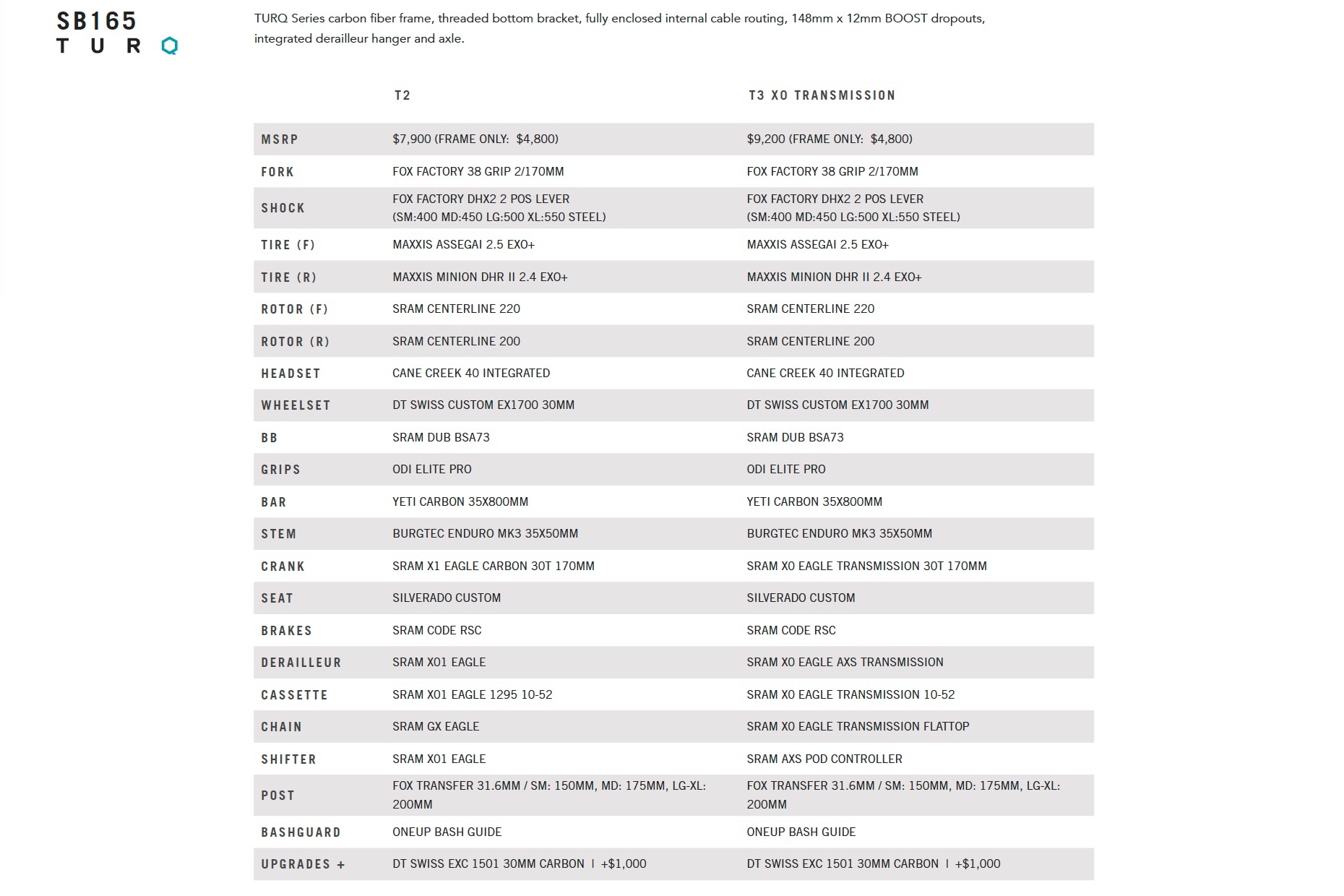
The C-Series builds come equipped with Fox Performance 38 forks (with the option to upgrade to Factory for $600), DT Swiss E1900 wheels, SRAM Code R brakes, Burgtec Alloy handlebars, and OneUp droppers. The C3 GX Transmission ($7,300) build comes with the SRAM GX Eagle AXS Transmission drivetrain, while the C3 ($6,300) uses GX Eagle mechanical shifting.
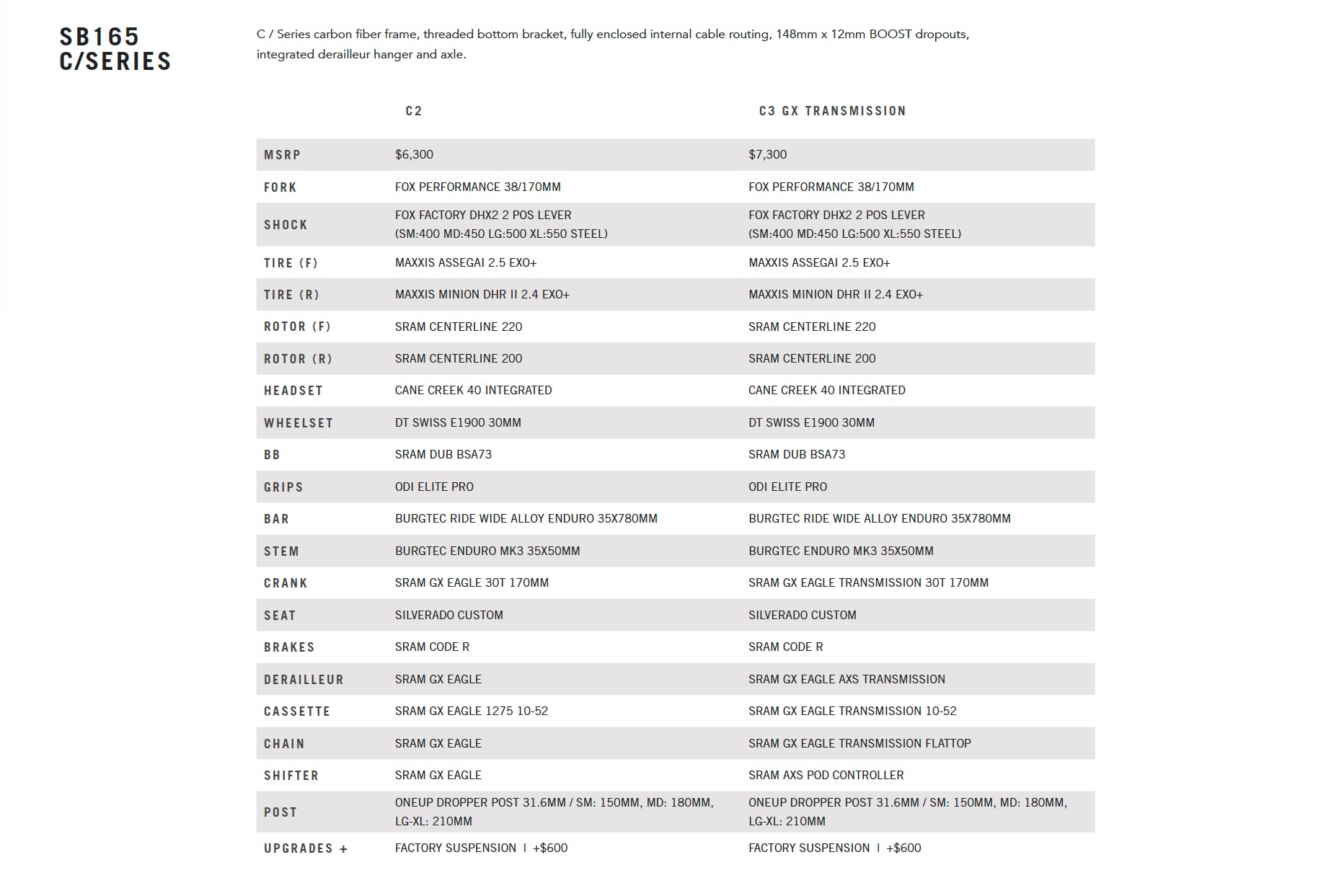
Actual Weight
The SB165 is a big, burly, and badass bike, so it comes as no surprise that it’s not super lightweight. Still, I was shocked to see that my size large T3 XO Transmission test bike in its stock configuration (tubeless, no pedals) clocked in at 34 lbs., 8 oz. While it certainly isn’t heavy for a bike in this travel bracket, it definitely felt heavy compared to the Yeti ASR that I was riding a few weeks ago, which tipped the scales at a scant 23 pounds — but that’s a pretty unfair comparison. When compared to similar bikes, the SB165 is a competitive weight.
SB165 Ride Impressions
I’ve had the new SB165 in my possession for a few weeks, and I’ve managed to get a few rides on it so far. I’ve only just scratched the surface of its capabilities, so my ride impressions are just that — impressions. Regardless, some of the local push-up and bomb-down steeps have woken up from their winter slumber, so I’ve gotten to ride it on some of the terrain for which it was designed. Unfortunately, my solo test rides and time constraints didn’t really allow me to get any decent riding photos, so I’m adding a few that Yeti sent in the media kit, which are way better than any shots I would have gotten anyway.
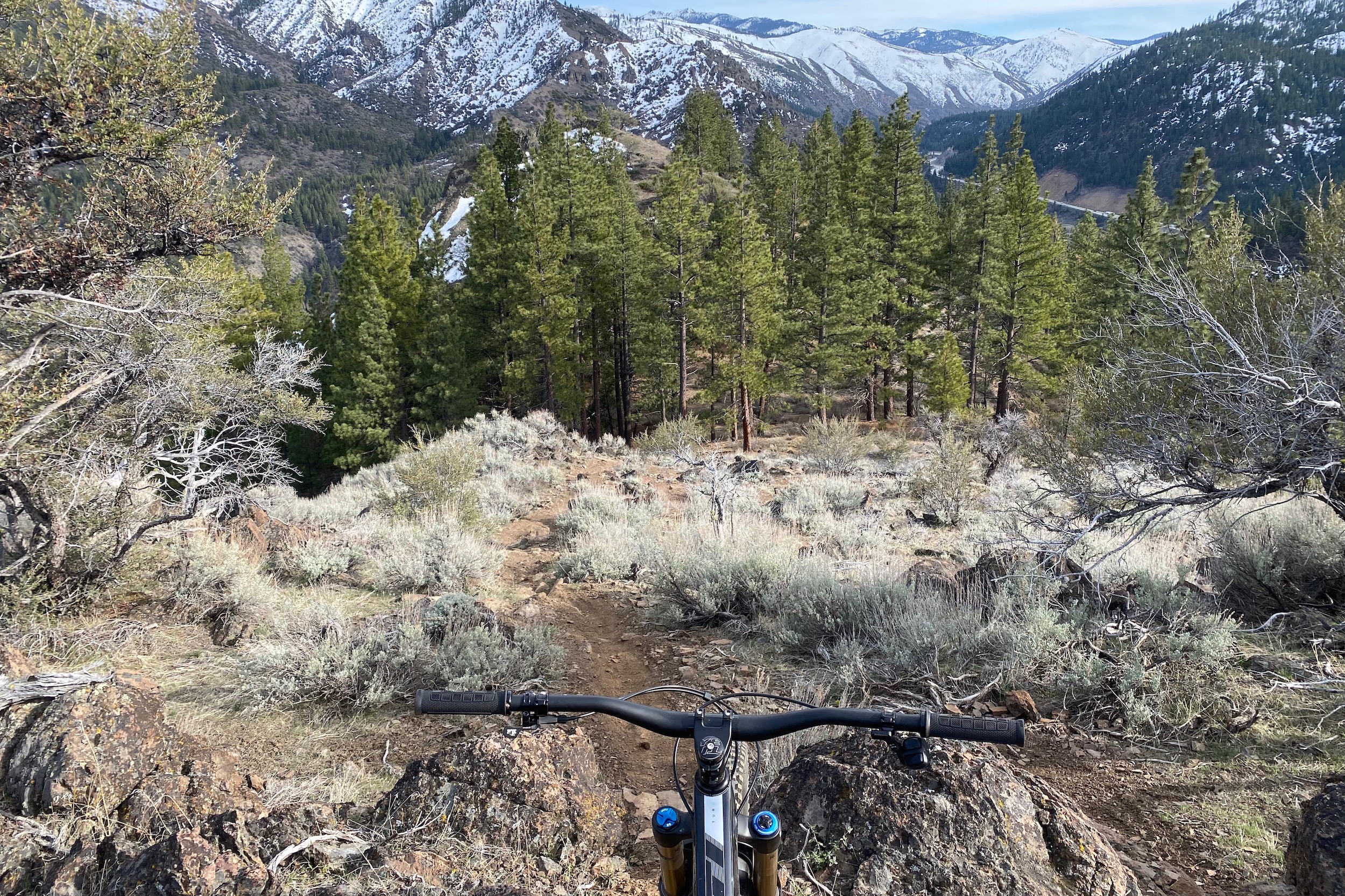
Climbing
When considering the climbing abilities of a bike like this, it’s important to remember that it’s designed to slay the descents. In that context, the SB165 climbs pretty darn well. One of the main things that stands out when climbing is just how calm the rear suspension is when seated. The Switch Infinity design and generous level of anti-squat are to thank for this, and there is barely any suspension movement noticeable when climbing in the saddle on smoother surfaces. So little, in fact, that the climb switch on the rear shock almost seems redundant to me. Out of the saddle, there is a little bit of bob, but certainly less than I expected from a long travel bike with a coil shock. Yet when you hit obstacles in the trail, the suspension opens up nicely.
With a steep seat angle and relatively tall front end, the seated pedaling position is pretty upright, super comfortable, and well-suited to fire road grinds to get you up to your favorite descents. On twisty singletrack, the SB165 can still handle just about anything your legs can, but with the tall and slack front end coupled with the relatively short rear center length, I found myself needing to lean my upper body way forward to navigate steeper uphill switchbacks. Admittedly, these particular corners are challenging even for people riding on e-bikes, but it took a little more focus and determination to make them than it does on my trail bike, for example.

Regardless, for a bike that essentially rides like a downhill bike on the descents, I found the fact that it pedals as well as it does to be quite impressive.
Descending
Not surprisingly, it’s on the descents that the SB165 really comes to life and shines. Of course, it depends on the descents in question, as it is definitely geared more towards steep, slashy, and rough terrain and seems to prefer higher rates of speed. When kept within its wheelhouse, however, it performs exactly how I would hope and expect. It also happens to be impressively quiet, with no cable rattle or other sounds that were annoying or disruptive of my focus while riding.
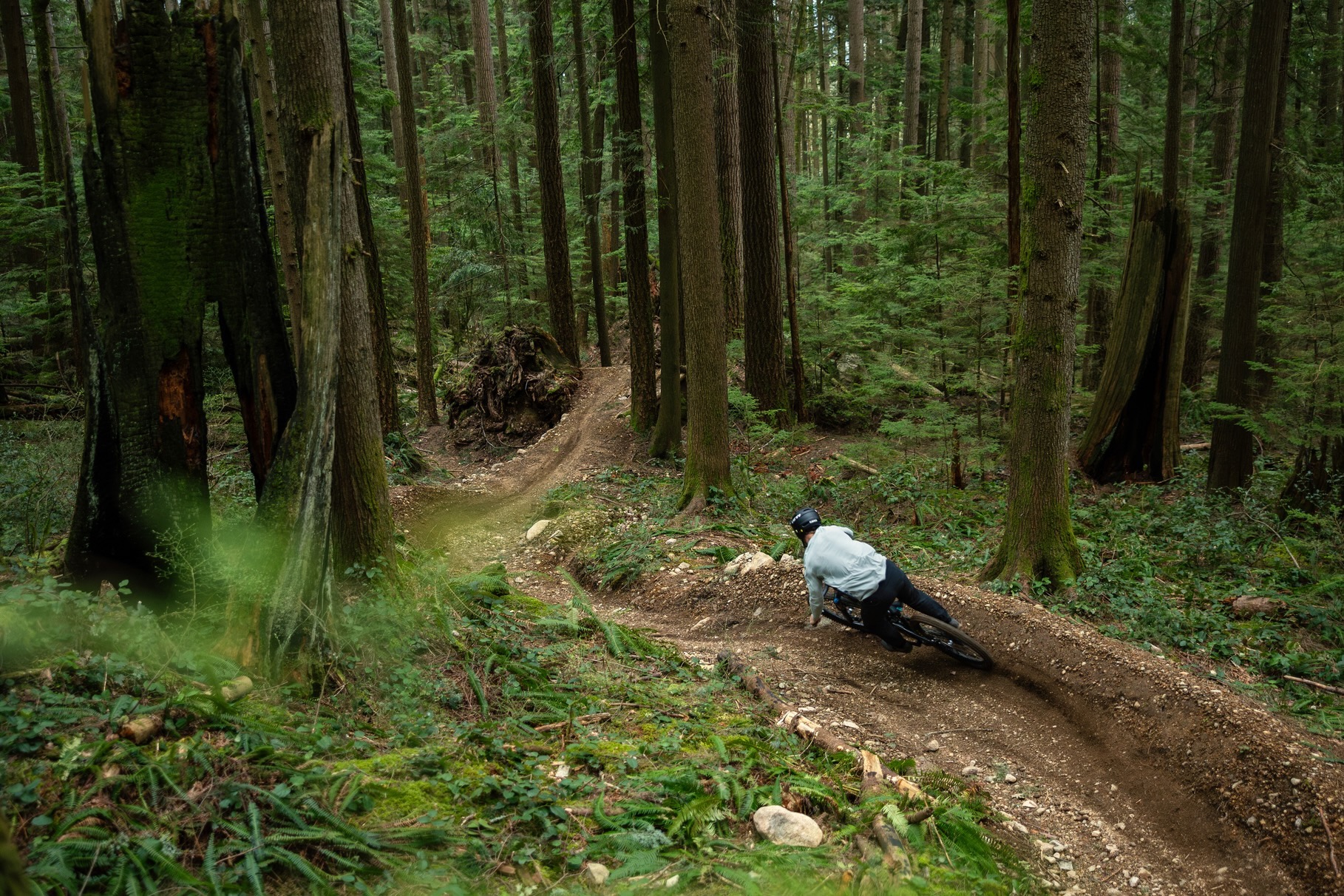
I found the SB165 to be very calm, composed, and damp feeling, whether blasting around a steep berm into a high-speed, sidehill straightaway or hitting a rock drop into a chunky rock garden. This bike oozes confidence, and for me, that translates to how I approach sections of trail that give me pause on my typical mid-travel trail bike. That feeling only seemed to get better as speeds increased and trails got steeper and more aggressive, and I found myself just rolling into and hitting several rock drops and gaps that usually make me think twice. Even at slower speeds, I didn’t find it to feel excessively bulky, assuming the pitch was still steep. The 27.5-inch rear wheel and relatively short rear center make it easy to whip it around, slash corners, and get the front wheel off the ground.
Of course, the 165/170mm of travel is significant, and I was impressed with its performance. Obviously, it’s always nice to ride fresh suspension, but Yeti’s Switch Infinity design works super well too. I don’t ride coil shocks all that often, but I really enjoyed the buttery feel of the first half of the travel. When loading it up in a compression or slamming through a rock garden, I also appreciated the support in the mid-stroke, and I definitely never felt close to bottoming it out.
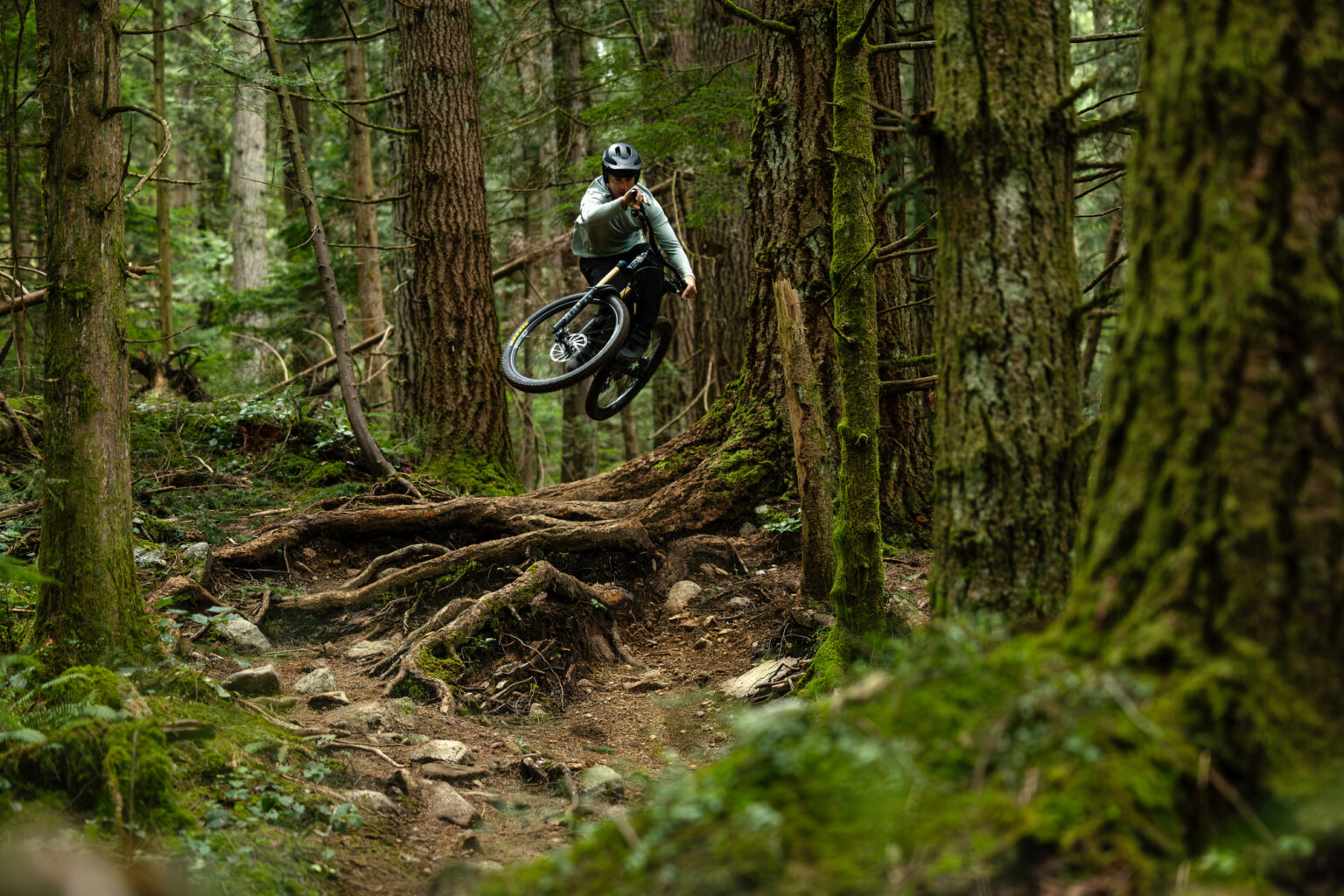
While some people will likely be bummed about the move to a mixed-wheel setup, I’ve grown to really appreciate them on certain bikes and in the right situations. For me, the 29-inch front wheel doesn’t detract at all from its handling while also rolling over obstacles a little more easily and being less likely to get hung up. At the same time, the 27.5-inch rear wheel keeps the SB165 true to its roots and maintains a relatively playful and agile feel for a bike of this size. On properly steep descents, the smaller rear wheel is less likely to rub on your butt, and the tall front end and cockpit mentioned previously help keep your body position from being too far forward.
Where the SB165 feels a little out of place is on mellow terrain. Like other bikes with similar travel and long, slack geometry, it just feels a bit bland and bulky when gravity isn’t on your side quite as much. This didn’t come as too much of a surprise to me given its intended use, as it’s clear the design priorities were focused elsewhere.
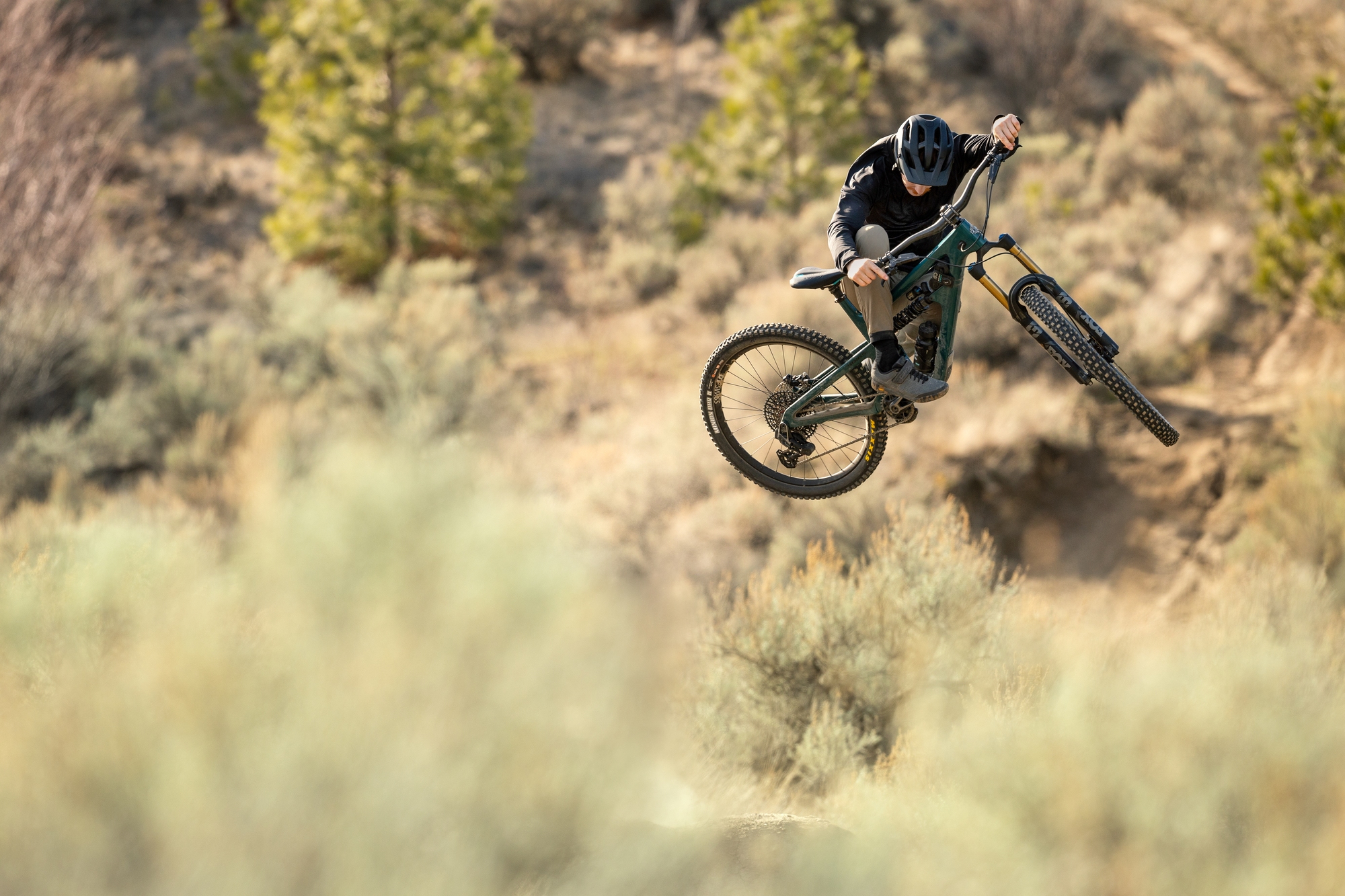
Yeti SB165 Parting Thoughts
While the updated SB165 isn’t a wild departure from the previous version, it’s a great example of ongoing refinement to keep it not only relevant but at the top of its class. I personally feel the move to mixed wheel sizes is a good one and the subtle changes to the geometry help to dial it in even better to its intended purpose as a bike park, freeride, and steep-slaying machine. I don’t ride much at the bike park, but if I did, I’d be inclined to get my hands on a bike like the Yeti SB165 so I can rip chairlift laps one day and pedal laps on winch-and-plummet type trails the next.
